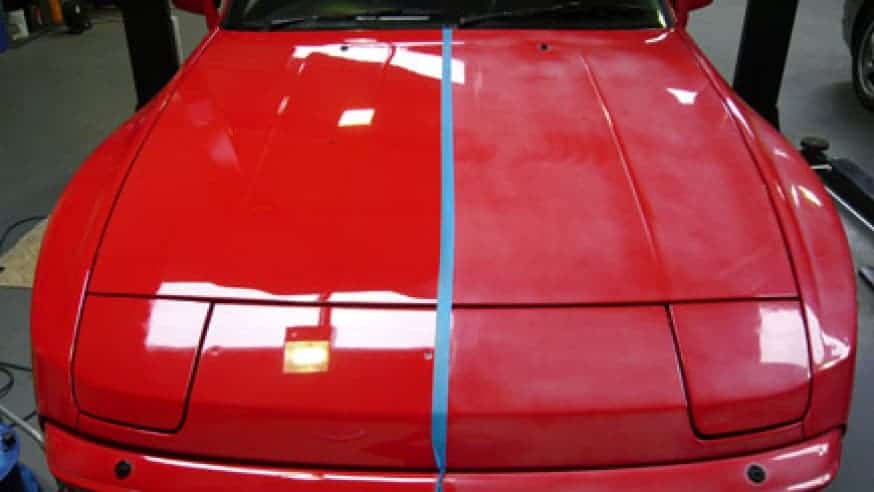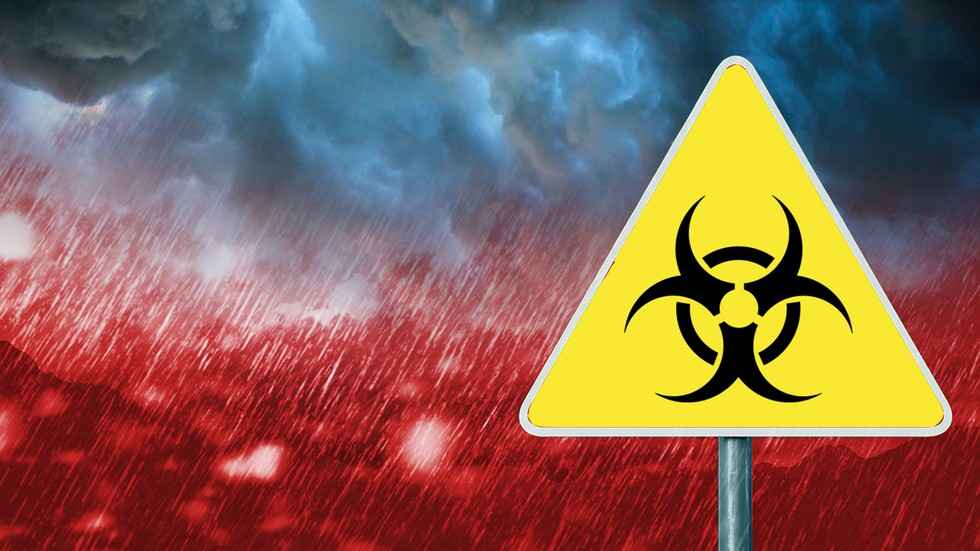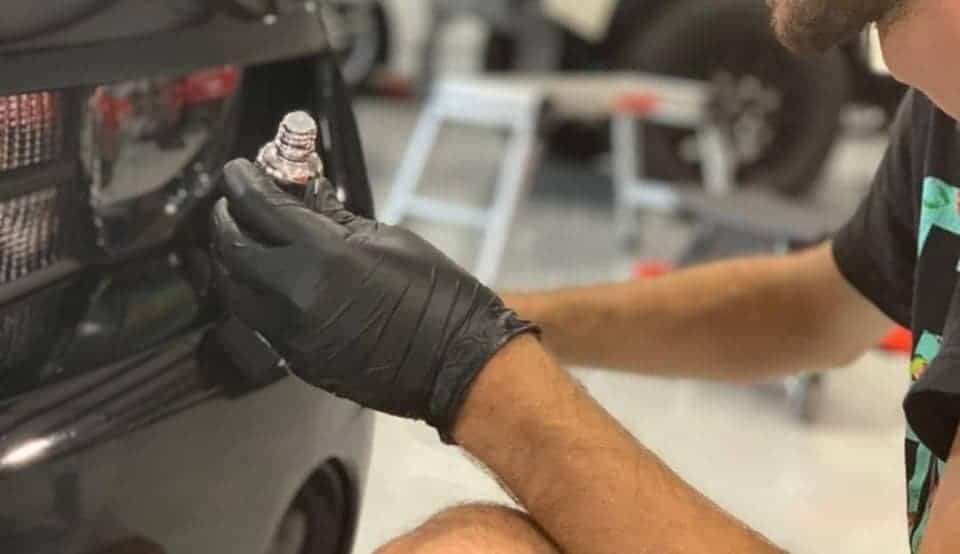I have to say, one of the sexiest things on the planet is a freshly polished glossy paint job on a vehicle. You know what I’m talking about – that deep look that makes you want to push your hand through the paint.
While automotive enthusiasts have several paint protection products like waxing your car that can extend the luster of their ride, the truth is – fading car paint is a reality we all have to deal with eventually.
But what causes car paint to fade?
It’s well understood that fading car paint can be attributed to excessive exposure to UV rays, contaminants, and frequent car washing. However, there are other items that can contribute to your paint color fading like a Dallas Cowboy or Oakland Raiders fan enthusiasm in December – just kidding, not kidding.
In the information below, we’ll outline a few of the most popular methods for damage to occur to the paint surface. We’ll also offer a couple of tips on how to reduce the potential of paint color deterioration, and a few of the best products you can use to extend the shine on your prized ride.
What are the Top Reasons for Faded Car Paint?

Automotive paint is applied using a four-step process. First, the bare surface is prepped by lightly sanding the material, which removes contaminants but also provides a microscopic cross pattern that allows the paint to adhere.
The second step is to apply a primer, that provides the base coat. Third, the actual paint is applied, usually in a few coatings, to ensure the entire surface area is well covered. Finally, a clear coating is applied on top of the paint, which provides an extra layer of protection. It’s the clear coat that displays swirl marks and other sources of paint damage.
So – with all of these steps, how can paint become damaged or fade?
Well – at its root source, paint fading is caused by oxidation. This chemical reaction happens when oxygen and heat are combined to break down the molecular bonds and structure of the paint. Once the oxidation process begins – it’s impossible to stop. However, there are some steps car owners can take to slow down oxidation or reduce it from happening in the first place.
There are four general sources of oxidation with automotive paint.
UV Rays

One of the most misunderstood sources of paint oxidation is assuming that direct sunlight causes oxidation. That’s not quite accurate. While oxidation is produced by the combination of heat and oxygen, the ‘heat’ is actually derived from UV rays. As UV light continually hits the clear coat, it slowly penetrates the coating and begins to heat the paint. This introduces oxygen to the under-layer of paint, and as heat is absorbed by the metal, fading occurs.
Salt

People living near ocean communities or the cold weather climates understand the negative impact that salt has on their equipment. Whether it’s causing rust on the undercarriage, motor mounts, exhaust pipes, or the body panels, salt f-in’ sucks.
Here is the real bitch – salt is NaCl, or sodium chloride, which is not an acid nor is it a base. However, it’s exceptionally corrosive. The real issue occurs when salt is left on a surface – especially when it’s exposed to our friend UV light. As it heats, those pesky salt crystals will slowly eat away at the clear coating, and eventually the paint surface. Eventually, it gets into the bare metal – and rapidly creates rust.
Abrasive Cleaners

There are some automotive cleaners that are good – and some that are paint killers. Typically, any cleaner that contains abrasive materials is a no-go for automotive enthusiasts. Essentially, abrasives act like sandpaper on your cars paint surface. When you use a washrag (even if its microfiber) it will dig into the surface and expose the under-layer of paint to UV light and oxygen – which leads to oxidation. Taking your car to the local car wash doesn’t help either.
Pollution

So – let’s get inside the average combustion engine for a second. Did you know that even the most fuel-efficient engines can only burn about 95% of the fuel that is introduced into the combustion chamber? It gets worse with diesel and other less refined fuels that have large-chain carbon molecules.
The remainder of unburnt fuel is expelled out of your exhaust system as ‘pollution’. Additional sources including burning coal, produce excessive amounts of carbon particulates and ends up on your exterior paint.
Carbon is comprised of microscopic molecules that are quite hard and jagged. This eventually causes scarring on the clear coat – and…yup, oxidation or faded paint. Pollution also causes acid rain.
How to Prevent Car Paint from Fading
When you review the root sources of faded paint above, it’s quite logical that the best way to prevent car paint from fading is to wrap it in car covers inside a bubble, store it in a vault, and never take it outside. Seriously – it’s virtually IMPOSSIBLE to PREVENT car paint from fading from a daily driver.
Now, if you were to have a PPF professionally applied, covered by the best DIY ceramic coating, after you wax your car and replace it every few years, the chances of your paint fading would be dramatically reduced. But, most of us are not financially blessed, have that much elbow grease or anal-retentive enough to follow through on this level of paint protection.
That being said, there are a few easier ways of reducing the potential of car paint fading.
Apply Natural Carnauba Wax

Down in Brazil, a special palm tree thrives. While it’s hammered with constant temperatures above 80 degrees and direct sunlight, this palm tree secretes a special ‘wax’ that protects the leaves, allowing them to continually grow in hostile conditions. This special palm tree shit is the primary ingredient in carnauba wax.
When a car owner applies a few coats of natural carnauba wax correctly, it will provide a fairly hard layer of protection that blocks UV rays, salt, and pollution. It’s not too great with abrasive cleaners, but nothing really is.
The main pain point of spray wax is that it only lasts about a month or so and requires constant removal and reapplication. Polish or polishing simply makes the paint shine and does nothing for protection.
Apply Paint Sealants

A paint sealant is synthetic and industrial-strength car wax. A sealant accomplishes the same task of providing a layer of protection against the same oxidation-causing sources. While it’s a bit stronger than car wax, it’ll only last up to 8 months or a year at the most.
Apply Ceramic Coatings
A ceramic coating or also called a nanocoating is a specially formulated blend of SiO2 (silica dioxide) or Quartz and other synthetic polymers that bond directly to the surface area of clear coats, plastic, vinyl, bare metal, even glass.
When it cures (which takes a matter of minutes initially – but a few days to fully cure) it quickly hardens to block UV rays, chemical, salt, and pollutants from penetrating the surface. This significantly reduces the potential of oxidation – and thus, paint fading.
Paint Protection Film

So basically, the paint protection film is a clear vinyl wrap on steroids. It’s a urethane polymer that is very thin and serves to protect protected surfaces from the same shit that causes oxidation. PPF can last up five years, although there is some pro-grade stuff that can last up to a decade.
Can You Fix Faded Car Paint?
Fixing faded car paint really depends on the level of damage that has been done to the paint. If the faded paint is caused by the clear coat itself, being ‘hazed’ – then it’s quite easy to ‘buff’ out the imperfections or damage to the clear coat. This is often referred to as paint correction or paint restoration. Before you attempt paint correction, however, you need to first determine the type of paint on your vehicle – especially the level of clear coating.
Today’s modern trucks, SUV’s and cars are sprayed with either a dual or single stage paint system. It basically blends the paint and clear coating on the single system, or sprays a base paint – then top layered clear costing for the dual.
Most are the dual-stage system that includes a urethane paint with added clear coating – that’s multiple layers of the same paint without color – with an added harder. For those with a clear coat on top of their base paint, there are a few ways to enhance the luster of your paint job.

But how can you tell if you’ve got a clear coat in the first place? It’s simple actually. Just look at your VIN plate – that’s located on the inside of your door. The plate has a certification label that includes a service part identifier code. This is where the paint code is located.
If you want to save time, just contact your dealership service department. Give them the VIN and they’ll tell you exactly what is applied to your ride.
Finally – you can test your clear coating level with some light grit sandpaper or paint thinner – like a 2,000 grit. Locate a section of your paint that isn’t too easy to see. Use some light pressure on that section, and see if the dust is the same color as the vehicle. If it’s not – the clear coat is still intact.
If you wipe that section lightly with the paint thinner and you don’t see any color on the rag, same thing. At this point, you can likely repair or enhance the clear coat. If there is color, however, you’ll need a new paint job or at the minimum, you’ll need a new clear coating.
If you’re curious about completing DIY paint correction, we have a bitchin article that goes through the whole process – even how to use a clay bar and other prep tasks.
Best Product to Prevent Car Paint from Fading
So – you’ve read the information above and are wondering what the best products to use to protect your car’s paint? Well, I hate to toot our own horn, but we sell a pretty damn good DIY ceramic coating called Armor Shield IX that does a phenomenal job of blocking UV rays, pollution, abrasive cleaners, and yes – even salt.
The best way is to explain how a ceramic coating works is to visualize them as a second layer of skin, or a sacrificial layer of protection over your car’s clearcoat.
Ceramic Coatings utilize nanotechnology, which are essentially tiny particles that form a very fine, thin layer completely invisible to the eye. Because these particles are so small, when applied to a surface, they seal all the pores making the surface hydrophobic (water-repellent), but also resistant to UV, scratches, chemicals, extreme heat and even anti-graffiti. This 9H ceramic layer is completely transparent.
| Features | Armor Shield IX | Regular Wax | Non-Protected |
|---|---|---|---|
| UV Protection |
|
|
|
| Corrosion Resistance |
|
|
|
| Scratch Resistance |
|
|
|
| Durability |
|
|
|
| Gloss |
|
|
|
Ceramic coatings last anywhere from two to five years, mainly based on the amount of prep work, the paint or surface condition, and the application of the product. This is about 10-times longer than car wax and a fraction of the cost or time needed to complete this task.
Wrapping it Up
The simple truth is that the world we live in today is hostile for automotive paints. They simply are not made like they were back in the good old da…ah shit, I’ve just gone full old dude.
But seriously, the best way to reduce the potential of faded paint is to hand wash your car (using the two-bucket method), and using a good paint protection product, like Armor Shield IX.
The simple act of washing your car every few weeks, removing surface contaminants (especially if you live in coastal or cold climates during winter months) will significantly reduce the potential of damaging your car’s paint.













1 comment
Zoe Campos
Thanks for reminding me that carbon found in air pollution can also cause my car’s paint to fade. I almost thought that keeping it all the time in the garage would help, but I think it can’t be avoided since I still use it occasionally. It might be better to consult experts and see if applying a paint protection film would help.
Thanks for reminding me that carbon found in air pollution can also cause my car’s paint to fade. I almost thought that keeping it all the time in the garage would help, but I think it can’t be avoided since I still use it occasionally. It might be better to consult experts and see if applying a paint protection film would help.